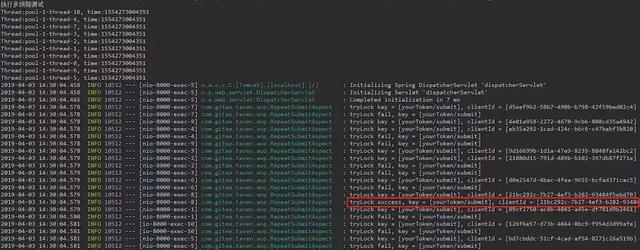上述的思路其实没有问题的,但是需要前后端都稍加改动,如果在业务开发完在加这个的话,改动量未免有些大了,本节的实现方案无需前端配合,纯后端处理。
思路
- 自定义注解 @NoRepeatSubmit 标记所有Controller中的提交请求
- 通过 AOP 对所有标记了 @NoRepeatSubmit 的方法拦截
- 在业务方法执行前,获取当前用户的 token(或者JSessionId)+ 当前请求地址,作为一个唯一 KEY,去获取 Redis 分布式锁(如果此时并发获取,只有一个线程会成功获取锁)
- 业务方法执行后,释放锁
这里只贴出 AOP 类和测试类
@Aspect
@Component
public class RepeatSubmitAspect {
private final static Logger LOGGER = LoggerFactory.getLogger(RepeatSubmitAspect.class);
@Autowired
private RedisLock redisLock;
@Pointcut("@annotation(noRepeatSubmit)")
public void pointCut(NoRepeatSubmit noRepeatSubmit) {
}
@Around("pointCut(noRepeatSubmit)")
public Object around(ProceedingJoinPoint pjp, NoRepeatSubmit noRepeatSubmit) throws Throwable {
int lockSeconds = noRepeatSubmit.lockTime();
HttpServlet request request = RequestUtils.getRequest();
Assert.notNull(request, "request can not null");
// 此处可以用token或者JSessionId
String token = request.getHeader("Authorization");
String path = request.getServletPath();
String key = getKey(token, path);
String clientId = getClientId();
boolean isSuccess = redisLock.tryLock(key, clientId, lockSeconds);
if (isSuccess) {
LOGGER.info("tryLock success, key = [{}], clientId = [{}]", key, clientId);
// 获取锁成功, 执行进程
Object result;
try {
result = pjp.proceed();
} finally {
// 解锁
redisLock.releaseLock(key, clientId);
LOGGER.info("releaseLock success, key = [{}], clientId = [{}]", key, clientId);
}
return result;
} else {
// 获取锁失败,认为是重复提交的请求
LOGGER.info("tryLock fail, key = [{}]", key);
return new ResultBean(ResultBean.FAIL, "重复请求,请稍后再试", null);
}
}
private String getKey(String token, String path) {
return token + path;
}
private String getClientId() {
return UUID.randomUUID().toString();
}
}
多线程 测试
测试代码如下,模拟十个请求并发同时提交
@Component
public class RunTest implements ApplicationRunner {
private static final Logger LOGGER = LoggerFactory.getLogger(RunTest.class);
@Autowired
private RestTemplate restTemplate;
@Override
public void run(ApplicationArguments args) throws Exception {
System.out.println("执行多线程测试");
String url="";
CountDownLatch countDownLatch = new CountDownLatch(1);
ExecutorService executorService = Executors.newFixedThreadPool(10);
for(int i=0; i<10; i++){
String userId = "userId" + i;
HttpEntity request = buildRequest(userId);
executorService.submit(() -> {
try {
countDownLatch.await();
System.out.println("Thread:"+Thread.currentThread().getName()+", time:"+System.currentTimeMillis());
ResponseEntity<String> response = restTemplate.postForEntity(url, request, String.class);
System.out.println("Thread:"+Thread.currentThread().getName() + "," + response.getBody());
} catch (InterruptedException e) {
e.printStackTrace();
}
});
}
countDownLatch.countDown();
}
private HttpEntity buildRequest(String userId) {
HttpHeaders headers = new HttpHeaders();
headers.setContentType(MediaType.APPLICATION_JSON);
headers.set("Authorization", "yourToken");
Map<String, Object> body = new HashMap<>();
body.put("userId", userId);
return new HttpEntity<>(body, headers);
}
}
成功防止重复提交,控制台日志如下,可以看到十个线程的启动时间几乎同时发起,只有一个请求提交成功了



